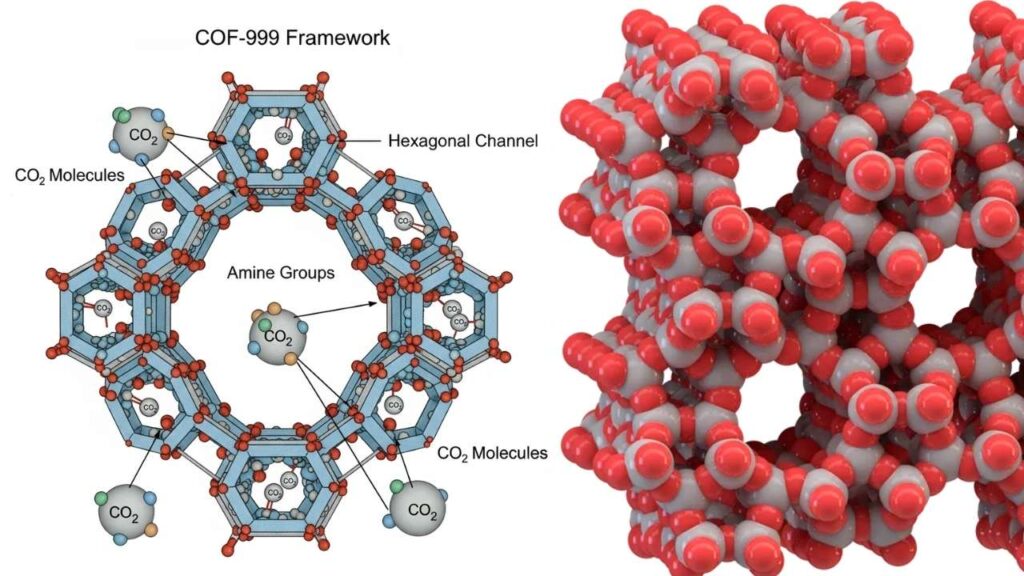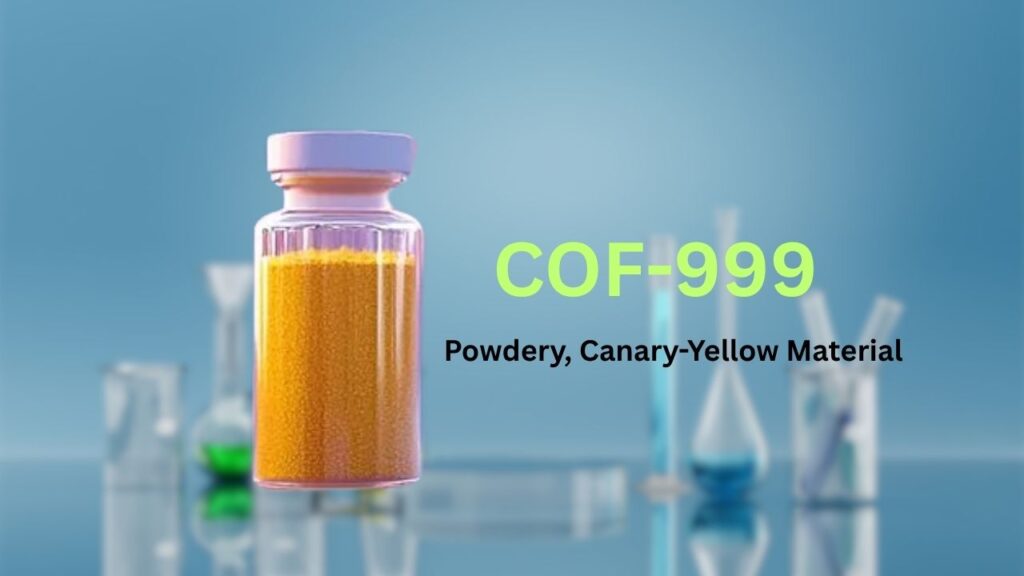Metal-Organic Framework COF-999: If you’ve been following the climate change conversation, you know carbon dioxide (CO₂) is the big bad wolf in the story. But what if I told you that a new material called COF-999—a type of covalent organic framework (COF)—is turning the tables and giving us a real shot at cleaning up our air? That’s right, folks: COF-999 is a game-changer in direct air capture (DAC) of CO₂, and it’s making waves from Silicon Valley labs to the heartland.

Let’s break down what this means for our planet, our jobs, and our future, in a way that’s as clear as a blue Montana sky.
Metal-Organic Framework COF-999
| Feature/Stat | Details & Data | Career/Professional Impact |
|---|---|---|
| Material Name | COF-999 (Covalent Organic Framework) | New opportunities in green tech & energy |
| CO₂ Capture Rate | 200g of COF-999 = 20kg (44 lbs) CO₂ per year (about what a mature tree absorbs) | Tech, engineering, and climate science |
| Energy Requirement | Releases CO₂ at just 140°F (60°C), much lower than other DAC materials | Lower operational costs |
| Durability | Survives 100+ capture-release cycles without degrading | Long-term use, less maintenance |
| Speed | Captures CO₂ up to 10x faster than other DAC materials | Faster project turnaround |
| Water/Contaminant Resistance | Stable even in humid or polluted air | Reliable in real-world conditions |
| Professional Fields Impacted | Chemistry, engineering, environmental science, construction, manufacturing | Career growth in sustainable industries |
COF-999 is a breakthrough material that could transform how we fight climate change. It’s fast, tough, and energy-smart—just what America needs to lead the world in clean tech. Whether you’re a kid dreaming of being a scientist, a pro looking to green your business, or just someone who loves a breath of fresh air, keep your eyes on COF-999. The future’s looking a little brighter—and a lot cleaner.
What Is COF-999 and Why Should You Care?
COF-999 is a powdery, canary-yellow material cooked up by some sharp minds at UC Berkeley. It’s part of a family called covalent organic frameworks—think of them as high-tech sponges with billions of tiny holes that can trap specific molecules. In this case, those holes are lined with amines (a type of chemical that loves to grab onto CO₂), making COF-999 a superstar at sucking carbon out of the air.
How Does It Work?
- Air flows through COF-999’s pores.
- CO₂ molecules stick to the amines inside.
- When the material is full, heat it up to 140°F (60°C)—about as hot as a summer day in Texas—and the CO₂ pops right off, ready to be stored or used.
This process is much less energy-hungry than older methods, which needed way higher temps and often broke down after a few uses.

Why Is COF-999 a Big Deal?
Let me put it in plain English: COF-999 is the LeBron James of carbon capture. Here’s why:
- Efficiency: 200 grams (not even half a pound) can pull as much CO₂ out of the air as a full-grown tree in a year.
- Speed: It works up to 10 times faster than other DAC materials, so you don’t have to wait around for results.
- Durability: It can be used over 100 times without losing its mojo—no more throwing away expensive filters every month.
- Energy Savings: Releases CO₂ at half the temperature needed by older tech, slashing power bills and making it greener to run.
- Water Resistance: Works even when the air is humid or dirty, so it won’t wimp out in real-world conditions.
How Does COF-999 Compare to Other Carbon Capture Methods?
Let’s break it down:
- Traditional DAC Materials: Often use liquid amines in water, which are messy, energy-hungry, and degrade fast.
- COF-999: Solid, stable, and efficient. It’s like swapping out your old gas-guzzler for a shiny new electric truck.
COF-999’s unique advantage? Its amine-lined pores are covalently bonded—that’s chemistry-speak for “super strong and not going anywhere.” This means it won’t lose its CO₂-grabbing power, even after a hundred rounds of use.
Practical Advice: How Can COF-999 Help Your Community or Business?
Whether you’re a rancher in Oklahoma, a city planner in Chicago, or a kid in school, COF-999 has something for you:
For Professionals and Businesses:
- Green Construction: Use COF-999 to capture CO₂ onsite and turn it into building materials like concrete or plastics.
- Manufacturing: Integrate COF-999 units into factories to offset emissions and meet new EPA standards.
- Energy Sector: Power plants can add COF-999 filters to smokestacks, reducing their carbon footprint without massive overhauls.
For Communities:
- Cleaner Air: Deploy COF-999 in urban parks, schools, or highways to scrub CO₂ and improve air quality.
- Job Creation: New tech means new careers—in chemistry, engineering, and environmental science.
For Families and Kids:
- Education: COF-999 is already being used in classroom experiments to show how science can help the planet.
- Inspiration: This is proof that American innovation can tackle big problems—maybe you’ll be the next scientist to make a discovery!
How to Use COF-999: Step-by-Step Guide
- Get the Material: Right now, COF-999 is mostly in the hands of researchers, but commercial versions are on the way.
- Install in Airflow: Place the powder in a cartridge or filter where air can pass through.
- Capture CO₂: As air flows, CO₂ sticks to the amines inside COF-999.
- Release CO₂: When full, heat the material to 140°F (60°C) to release pure CO₂.
- Store or Reuse: Store the captured CO₂ underground or use it in manufacturing; reuse the COF-999 filter again and again.
Quantum Multimode Encoding Breakthrough Promises Higher Data Density and Efficiency
Photonic Quantum Processors Show Enhanced Machine Learning Capabilities Even at Small Scale
FAQs About Metal-Organic Framework COF-999
Q: Is COF-999 safe for people and pets?
A: Yes! It’s a solid powder that stays put in its filter. No toxic fumes, no mess—just clean air.
Q: How much CO₂ can it really capture?
A: 200 grams (less than a can of soda) can pull 44 pounds of CO₂ a year—about what a mature tree does.
Q: How long does it last?
A: Over 100 cycles with no loss in performance. That’s years of use before needing replacement.
Q: Can it be used in homes?
A: Right now, it’s aimed at big projects, but home-sized filters are on the horizon. Stay tuned!
Q: Where can I learn more or get involved?
A: Check out UC Berkeley’s COF-999 project.
The Big Picture: What’s Next for COF-999 and Carbon Capture?
COF-999 is still fresh out of the lab, but it’s already making waves. Experts say it could help the U.S. and the world hit net-zero targets by 2050, especially as industries and governments race to cut emissions.
But let’s keep it real: Direct Air Capture is just one piece of the puzzle. We still need to cut fossil fuel use, plant more trees, and support clean energy. COF-999 is a powerful tool, but it works best as part of a bigger, bolder climate action plan.






